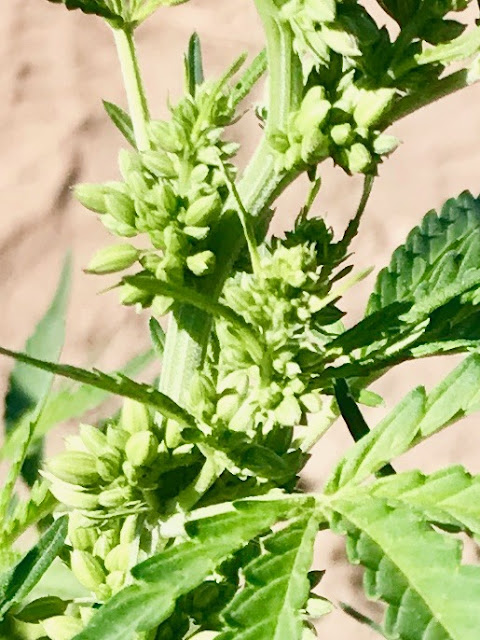Southern Oregon has the climate, the laws, the expertise, and the labor necessary to grow hemp.
It was wildly profitable in 2017 and 2018.
It is possible high margins for southern Oregon farmers will continue. Hemp is complicated, and we have the human capital here.
No THC. A CBD-only field is the result of complicated selective breeding. THC in the plant ruins the crop, so the specially created seeds cost a dollar or more per seed. There are typically 2000 plants per acre, and not every seed germinates, and not every germinated seed grew successfully to transplant size.
Labor intensive work: No males. The hemp fields are intended to be entirely female plants which are left un-pollinated. Un-pollinated plants create higher levels of CBD as the plant stresses and produces sticky resins as it seeks the pollination that never comes. Un-pollinated plants mean more CBD and no seeds. Seeds significantly reduce the value of the crop.
 |
| Male close up |
Normally half the plants are males. Seed breeders get seeds that produce only female plants by forcing a female plant to create pollen, which pollen is then used to pollinate another female plant. The resulting seeds have two mothers, and that produces only female plants.
A female plant makes pollen? Yes. It can happen.
One gets a female plant to create pollen by spraying it with colloidal silver at the right time. It is difficult, precise work, which is why feminized seeds are expensive, and why some supposedly feminized seeds turn out to produce male offspring.
Here is a guide to how to do it: Click Here is another: Click
Here is a guide to how to do it: Click Here is another: Click
Sometimes, even when the feminization process was done correctly, a male plant is discovered in a field, and it isn't always done correctly. Seed quality is uneven. In a well managed grow site, field workers walk through their fields weekly, looking closely at each plant, hunting for males. Ideally, they are found when young. Sometimes they are missed, and sometimes the plants hermaphrodite, i.e. a female plant become male on their own late in the season.
Field workers who spot a male plant like the one shown here do not simply pull it out. Pulling it out would shock the plant and the pollen bulbs would explode while being pulled, spreading pollen everywhere, pollinating hundreds, maybe thousands, of plants. Instead, the correct practice is to wet the plant with water then carefully put a plastic bag over the whole plant, cinch it at the bottom, and then pull the whole plant, thus containing the pollen.
Male and female plants look different, if one knows what to look for. The male hemp plant, in this critical moment when it would be ready to explode its pollen, is covered with little balls, each oval ball a little bigger than the head of a pin, e.g. 3 millimeters.
 |
| Female close up |
The female plant lacks those ball sacks and instead has long strands of hair, designed to catch the pollen emitted by a male.
Southern Oregon has "first mover" advantage in growing hemp. Our growers here got experience back in the days when growing was illegal, and then during the years when one could grow a THC plant legally for medical patients.
Many of those growers have transitioned to growing big fields of hemp for CBD.
The plant is vigorous, but to create a marketable crop the grower needs to deal with plant genetics and breeding in its infancy, with insect pests, with weeds, with mold problems, with the potential of too much THC, with complicated fertilization and watering schedules, with cumbersome state rules, with labor intensive planting, tending, and harvesting, with drying the crop, new marketing and distribution for a crop whose value is just being discovered, and as described here, with male plant contamination.
Labor Day.
Lots can go wrong, and it takes expertise and crews of skilled and semi-skilled workers. The economic opportunity is that well paid entrepreneurs and workers thrive here and bring outside money into the region. A reliable skilled worker willing and able to walk the field in the hot sun has market leverage. A worker can actually make a living, pay for an apartment, buy a house and car, pay off student loans, and enhance the local economy.
Lots can go wrong, and it takes expertise and crews of skilled and semi-skilled workers. The economic opportunity is that well paid entrepreneurs and workers thrive here and bring outside money into the region. A reliable skilled worker willing and able to walk the field in the hot sun has market leverage. A worker can actually make a living, pay for an apartment, buy a house and car, pay off student loans, and enhance the local economy.
Of course, it also means that employers in the hospitality and other low wage industries need to raise their wages to retain workers. Why wash dishes for $12 and hour when a hemp grower is desperate to pay $15 and $20 to have a worker do a time critical task?
Hemp margins may persist a while. The complications of hemp production also means Midwest farm belt growers, accustomed to farming thousands of acres of corn, soybeans, and wheat with huge equipment, may not be competitors. There is too much specialized knowledge and hand work.
The current gold rush atmosphere cannot last forever, but it may not be over, not yet.
The current gold rush atmosphere cannot last forever, but it may not be over, not yet.


1 comment:
During October aka Potober local nursing homes become dangerously understaffed as their $11.50 / hour care giving workers quit and go work in the pot fields for $20 / hour tax free. Elderly and infirm residents’ safety become endangered.
Always the unintended consequences.
Post a Comment